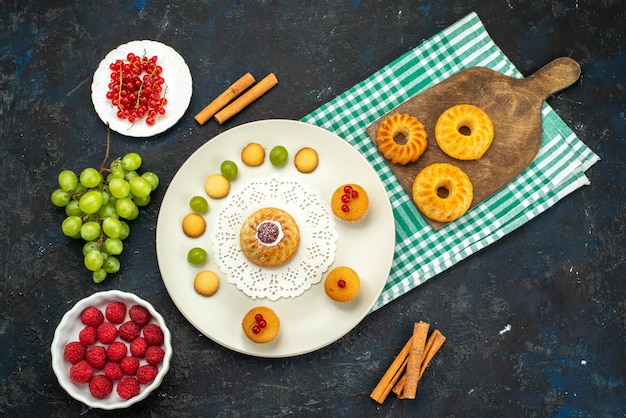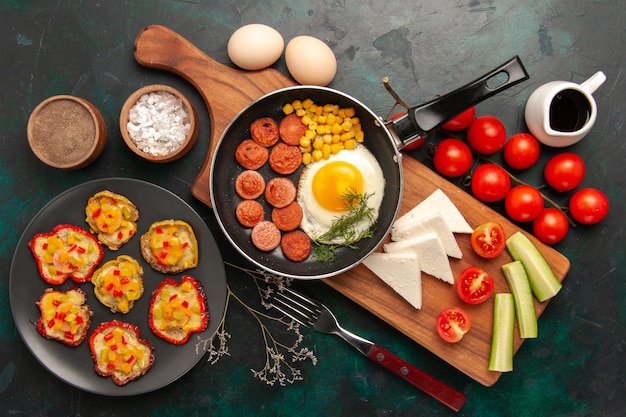Let's talk omelettes. Now, I know what you're thinking: "Omelettes? That's easy, anyone can do that!" And you'd be right, in a way. But trust me, there's a world of difference between a basic, slightly rubbery omelette and a fluffy, perfectly cooked one that melts in your mouth. I'm not talking about fancy Michelin-star creations here, just a simple, delicious breakfast, brunch, or even light dinner that's a breeze to make, even if you're a complete culinary newbie.
I still remember my first attempt at an omelette. It was a bit of a disaster, to be honest. I was so focused on whipping up the eggs that I forgot about the cheese, and then I completely overcooked the whole thing. But hey, we all start somewhere, right?
Over time, I learned from my mistakes and perfected my omelette-making skills. And today, I'm sharing all my tips and tricks with you. We'll cover everything from the right pan to the best folding technique. And don't worry, it's all very simple – no fancy equipment or confusing recipes needed. So grab your apron, let's get cooking!
(Part 1) Gather Your Tools

Before we get our hands dirty, let's make sure we have all the right tools for the job. You don't need a gourmet kitchen to whip up a delicious omelette. Just a few essentials will do.
1. The Pan: Your Canvas for Perfection
The pan is the foundation of your omelette experience. A good pan is crucial for achieving that perfect golden-brown crust and ensuring your omelette cooks evenly without sticking. You want something that's not too big and not too small, with even heat distribution.
I usually go with a good old-fashioned non-stick pan, about 8-10 inches in diameter. You don't need anything fancy, just something reliable and easy to clean. Now, I'm not a fan of those pans with the flashy, brightly colored non-stick coating. They tend to lose their stick-free properties after a while. I prefer a classic, darker-colored, well-seasoned pan.
And before you even think about using a Teflon pan, please reconsider. While it may seem like a convenient option, Teflon can release harmful chemicals when heated to high temperatures. So stick to a good old-fashioned non-stick pan, which has proven to be safe and reliable. You can even opt for a cast iron pan – it's heavy-duty and durable, but it takes a bit more care.
2. The Spatula: Your Omelette Buddy
A good spatula is essential for flipping your omelette without tearing it. Look for a flexible spatula with a flat, wide blade. I personally love silicone spatulas. They’re heat-resistant, won’t scratch your pan, and are easy to clean. Plus, they come in a variety of fun colors to brighten up your kitchen.
3. The Whisk: A Must-Have for fluffy omelettes
A whisk is your best friend when it comes to creating light and fluffy omelettes. It’s crucial for whipping up the eggs and incorporating air, which gives the omelette its texture. You can use a simple balloon whisk or a handheld electric mixer. I prefer a balloon whisk because it’s easy to use, clean, and affordable. A small handheld electric mixer is great, too, but it can feel a little overkill for omelettes. Honestly, for most of us, the simple balloon whisk will do just fine.
4. The Bowl: Your Egg Mixing Station
You’ll need a bowl to mix your eggs. Choose a bowl that’s big enough to accommodate your desired amount of eggs, but not so big that it makes mixing difficult. A medium-sized bowl, around 1-2 liters, should be just right. I prefer glass bowls because they’re easy to clean and don’t absorb any odors. But really, any bowl you have lying around will do.
(Part 2) The Magic of Eggs: Getting Them Ready

Now that we have our tools, let’s talk about the stars of the show: the eggs. The right eggs can make all the difference in the final product.
1. Egg Choice: Fresh is Best
Always use fresh eggs for the best omelette. You can tell if an egg is fresh by checking its date or doing a little float test. Just place the egg in a bowl of water. If it sinks to the bottom, it’s fresh. If it floats, it’s old. But don’t worry, I hardly ever do the float test. I usually check the date on the carton, just to be safe.
2. Egg Quantity: It’s All About Balance
The number of eggs you use depends on the size of the omelette you want. For a small, single-serving omelette, 2 eggs should do the trick. For a larger omelette that can be shared with a friend, 3-4 eggs are perfect. Experiment and find what works best for you.
3. Egg Temperature: Warm Up for Fluffiness
Here’s a secret tip for creating the fluffiest omelettes: warm up your eggs before you whisk them. This helps the proteins in the eggs to relax and create a lighter texture. You can simply let the eggs sit out at room temperature for 30 minutes before use. Just make sure they're not too warm, as you don’t want them to become runny.
(Part 3) The Whipping Process: Airy and Light

Now, the fun part: whipping the eggs. This is where you get to transform your eggs from a simple mixture into a fluffy, airy cloud. It's the key to achieving that delicate texture and preventing a rubbery omelette.
1. The Art of Whipping: Getting the Right Consistency
This is where a whisk, or even a fork, comes in handy. You want to whisk the eggs until they become light and frothy. This means incorporating air into the egg mixture, which is what gives the omelette its lightness and texture. It should look like a pale yellow, foamy mixture.
As you whisk, you’ll notice the mixture becoming lighter and airier. The volume will increase, and you'll see tiny bubbles forming. It's like magic!
2. The Time Factor: Patience is Key
Don’t rush the whipping process. It’s better to over-whisk than to under-whisk. Take your time, and you’ll be rewarded with a more delicate omelette. I usually whisk for about 2 minutes, but it can vary depending on the amount of eggs and the power of your whisk.
3. Don’t Be Afraid to Be Vigorous: Go for It!
Whisk vigorously. Don’t be afraid to get your arm working. The more air you incorporate, the fluffier the omelette will be. And remember, the key is to create a nice, light, airy foam.
(Part 4) Mastering the Pan: The Foundation of Success
Okay, the eggs are prepped, and we’re ready to move on to the pan. This is where the magic really happens.
1. Preheat for Perfection
Before you even think about adding the eggs, preheat your pan over medium heat. This is crucial for ensuring even cooking and preventing the omelette from sticking to the pan. You want the pan to be hot, but not smoking.
You can test if your pan is hot enough by flicking a few drops of water onto the surface. If the water sizzles and evaporates quickly, you’re good to go.
2. The Grease Factor: A Tiny Amount Will Do
Add a small amount of oil or butter to the pan. A teaspoon should be enough. You don’t want the pan to be swimming in oil, just lightly greased to prevent sticking. My favorite grease for omelettes is a small knob of butter. It adds a lovely flavor to the omelette.
As the butter melts and sizzles, it creates a thin, even layer on the surface of the pan, which will help to prevent your omelette from sticking.
(Part 5) Time to Cook: The Art of the Flip
Now for the exciting part – cooking the omelette. This is where your patience and technique will be put to the test. It's a bit of a balancing act, but you'll get the hang of it soon enough.
1. The First Layer: A Gentle Pour
Pour the whisked egg mixture into the hot, greased pan. Do it gently so the mixture spreads evenly. You don’t want to create any air bubbles or holes in the omelette. Let the omelette cook for a minute or two, undisturbed.
As the eggs cook, you'll notice the edges starting to set and the top becoming slightly opaque. This is a sign that it's almost ready to flip.
2. The Flip: Timing is Key
Now comes the crucial part – flipping the omelette. This takes a bit of practice, but you'll get the hang of it soon. You want to flip the omelette just before it becomes completely solid. If you wait too long, it will become rubbery. The telltale sign that it’s ready to flip is when the edges start to set and the top begins to look slightly opaque.
Don’t be afraid to lift a corner with your spatula and peek underneath. If the bottom is nicely browned and the top is still slightly wet, it’s time to flip.
3. The Flip Method: Mastering the Technique
There are a few ways to flip an omelette:
- The Classic Fold: This is the most common method. Use your spatula to lift the edge of the omelette closest to you and gently fold it over the other half. Then slide your spatula under the entire omelette and flip it over. It should be a smooth, fluid movement.
- The Slide and Roll: This technique is a bit trickier but can result in a perfectly round omelette. Use your spatula to carefully lift one side of the omelette and gently slide it towards the center. Then, roll the omelette over towards the other side. It’s like a little culinary acrobatics trick!
- The Plate Flip: If you’re feeling daring, you can try the plate flip. Place a plate over the pan, and carefully flip the pan upside down. The omelette should land perfectly on the plate. I wouldn’t recommend this for beginners, as it can get a bit messy.
4. The Second Side: Cook Quickly and Gently
Once you’ve flipped the omelette, cook the other side for about 30 seconds. You want it to be cooked through but still soft and moist. Don’t overcook it, as it will become dry and rubbery.
You can tell it’s done when the underside is golden brown and the top has just a slight amount of give when you press on it lightly.
(Part 6) Fillings and Flavors: The Fun Part
Now for the fun part – adding your favorite fillings. The possibilities are endless, so get creative!
1. Before or After: Timing is Everything
You can add your fillings before you flip the omelette or after. If you add them before, they’ll get cooked into the omelette. If you add them after, they’ll stay fresh and juicy. It’s up to you – experiment and see what you prefer.
If you’re adding fillings like mushrooms or spinach, which need to be cooked, it’s best to add them before flipping the omelette. But if you’re adding something like cheese or herbs, you can add them after.
2. Classic Combinations: The Tried and True
Here are some classic omelette fillings that you can never go wrong with:
- Cheese and Ham: A simple and satisfying combination.
- Mushroom and Swiss: A classic French-inspired filling.
- Spinach and Feta: A healthy and flavorful option.
- Onion and Tomato: A simple but tasty filling.
- Bacon and Cheddar: A classic American favorite.
3. Beyond the Classics: Explore New Frontiers
Don’t be afraid to experiment with new and exciting fillings. Some of my favorites include:
- smoked salmon and Cream Cheese: A luxurious and decadent treat.
- Roasted Red Peppers and Goat Cheese: A burst of flavor and color.
- Avocado and Chorizo: A spicy and satisfying combination.
- Sautéed Shrimp and Asparagus: A light and healthy option.
The beauty of omelettes is that they're incredibly versatile. You can use whatever you have on hand, so feel free to get creative and experiment with different flavor combinations.
(Part 7) Finishing Touches: The Final Flourish
The omelette is almost done, but we need to add those finishing touches that elevate it from good to great.
1. Garnish for Glory: A Final Touch of Elegance
Add a garnish to your omelette to make it look and taste even better. Some popular garnishes include:
- Fresh Herbs: A sprinkle of chopped parsley, chives, or cilantro.
- Chopped Tomatoes: A burst of freshness.
- Shredded Cheese: A classic finishing touch.
- Sliced Avocado: A creamy and healthy addition.
A simple garnish can really elevate the look of your omelette and add a touch of elegance. It's a great way to add a burst of color and flavor to your dish.
2. Seasoning Magic: Bringing Out the Flavor
Don’t forget to season your omelette! Salt and pepper are essential, but you can also add other spices, herbs, or even a squeeze of lemon juice. A pinch of paprika or cayenne pepper can add a touch of heat.
Seasoning your omelette is important for bringing out the flavors of the eggs and fillings. Don't be afraid to experiment with different herbs and spices to find what you like best.
(Part 8) Serving Up: Ready to Enjoy
And there you have it – your perfect omelette! It’s time to serve it up and enjoy. I like to serve mine with a side of toasted bread, fruit, or a salad.
A perfect omelette is all about balance – a fluffy, light texture, perfectly cooked eggs, and delicious fillings. So go ahead, give it a try and enjoy your culinary masterpiece!
FAQs
Here are some frequently asked questions about omelettes:
| Question | Answer |
|---|---|
| What if my omelette sticks to the pan? | If your omelette sticks, don’t panic! It’s probably because the pan wasn’t hot enough or wasn’t greased properly. Next time, try preheating the pan for a little longer and adding a bit more oil or butter. |
| How do I get a perfectly round omelette? | Getting a perfectly round omelette takes practice. Try using the slide and roll method or tilting the pan slightly while cooking to encourage the omelette to spread evenly. |
| Can I make omelettes in advance? | While you can make omelettes ahead of time, they’re best served fresh. If you need to make them in advance, try cooking them fully, then reheating them gently in the oven or microwave. |
| What if my omelette is too dry? | A dry omelette is often the result of overcooking. Next time, try cooking it for a shorter period and flipping it sooner. You can also add a little bit of milk or water to the egg mixture before cooking. |
| What if my omelette is too runny? | A runny omelette means that the eggs weren’t cooked long enough. Try cooking it for a little longer and flipping it later. You can also add a little bit more egg yolk to the mixture. |
I hope this guide has helped you to create your own perfect omelette. Remember, practice makes perfect. Don’t be afraid to experiment and find what works best for you. And most importantly, have fun!
Everyone is watching

Corn on the Cob: The Ultimate Guide to Perfectly Cooked Ears
Healthy MealsAh, corn on the cob. Just the name evokes images of sunny days, barbecues, and that sweet, juicy flavour that ...

Scallops: The Ultimate Guide to Perfect Cooking
Healthy MealsAh, scallops. Those delicate, sweet, and utterly delicious morsels of the sea. They hold a special place in my...

Spaghetti Squash: The Ultimate Guide to Cooking and Serving
Healthy MealsRemember that time you saw spaghetti squash at the supermarket, looking all bumpy and strange, and thought, "W...

Salmon Cooking Times: Perfect Guide for Every Recipe
Healthy MealsLet me tell you, cooking salmon is an art form. It's all about getting that perfect balance: juicy and tender,...

Ham Cooking Time: How Long to Bake, Smoke, or Boil a Delicious Ham
Healthy MealsAh, ham. It's a classic, isn't it? A real crowd-pleaser, especially around holidays. And when done right, it'...
